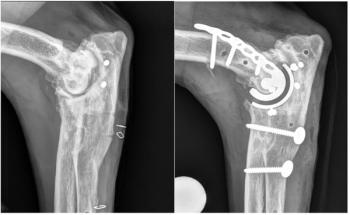
Rational use of NSAIDs for chronic pain in dogs and cats (Proceedings)
Pain can be protective, but through the stress response it may also contribute significantly to patient morbidity and even mortality. Undermanaged acute (peri-operative or post-trauma) pain can slow or even prevent recovery, and chronic pain is not merely acute pain of extended duration.
Pain can be protective, but through the stress response it may also contribute significantly to patient morbidity and even mortality. Undermanaged acute (peri-operative or post-trauma) pain can slow or even prevent recovery, and chronic pain is not merely acute pain of extended duration. Rather, it is a maladaptive state whereby the discomfort transcends the original injury or stimulus, and becomes instead an innate feature of the central nervous system. Many modalities may be employed to minimize both acute and chronic pain, but it is clear that non-steroidal anti-inflammatory drugs will likely remain the most commonly used tool in the toolbox. They are highly effective, commonly available, licensed for use in dogs, and generally quite safe...but at the same time do carry the potential for adverse effects that might range from the mild to the catastrophic.
The primary mode of action is to inhibit cyclooxygenase 2 (COX2), the enzyme that is expressed at site of inflammation and results in the production of pro-inflammatory and vasoactive prostaglandins. Also, through poorly understood mechanisms, likely by modulating multiple gene expression pathways, it may inhibit central perception of pain. Several superior products are now labeled for use in dogs (and some in cats), making them among the most popular of pain management medications in veterinary medicine. All seem to be effective, and head to head studies now emerging may help to reveal objective differences if they are present. The main limitation of all NSAID's revolves around the potential for adverse effects, since both COX 1 and COX 2 enzymes may be constitutive, that is, consistently present and crucial to the production of cyto-protective prostaglandins (COX1 especially in the GI tract and renal tubules, COX2 in the renal tubules). Thus the primary adverse effects of non-selective NSAID's may include GI erosion/ulceration and nephrotoxicity. COX1-sparing NSAIDS should have a dramatically diminished GI toxicity profile, but will maintain their risk for nephrotoxicity. Rarely and on an idiosyncratic basis, hepatoxicity may occur. The GI and renal adverse effects can be expected to occur most commonly in higher risk patients, e.g.: hypovolemia, hypotension (including anesthetic procedures especially those not supported by intravenous fluids), pre-existing GI or renal disease, overusage, and the inappropriate combination with other NSAID's or corticosteroids. Notable in this last category is client use of aspirin in their pets, which may be unbeknownst to the clinician unless specifically queried in a thorough history. Unique to aspirin, this NSAID produces a cyto-protective lipoxin through the COX pathway; thus when COX is inhibited through the use of another, concurrently-given NSAID, the potential for GI toxicity is considerably enhanced. The relative roles and molecular dynamics of COX1, COX2, and a possible new variant COX3, is still being elucidated and the "final word" on the optimal COX-selective or –sparing effect in order to maximize effectiveness and to limit toxicity, is yet to be heard. Acetaminophen may elicit some of its analgesic effects by inhibiting the COX3 variant, and recent studies suggest that it may also inhibit COX2-mediated production of PGE2. Lipooxygenase also metabolizes arachadonic acid, but instead of prostaglandins the byproducts are leukotrienes, which are potent attractors of PMN's and promote their adherence to endothelium. One commercial veterinary NSAID, tepoxalin, inhibits LOX as well as balanced COX enzymes. In any use of NSAID's, the potential for adverse effects needs to be made clear to pet owners, and for any extended use, regular metabolic monitoring should be performed.
The long-term use of NSAID's increases the chances of adverse effects, in particular GI and nephrotoxicity. One study looking at 19 cases of NSAID-induced GI perforation in dogs established that >90% of these patients were given concurrent corticosteroids or another NSAID (or no washout period between two different NSAIDs), or were given higher than recommended doses for extended periods of time. To wit, the American Gastroenterological Association reports that 44% of respondents in a survey reported personally using higher than the recommended doses of NSAID, and up to 40% of pet owners may give their pets' aspirin at one time or another. Thus the veterinary clinician must be strident in their query of pet owners about other medications in the pet's history, and in their instructions about chronic usage. In general, a 5-day washout between NSAID's is recommended, and 10 days specifically for aspirin. Strict monitoring of clinical status and renal and hepatic values becomes a vital part of long-term NSAID usage. NSAID's have been used, although cautiously, in patients with stable chronic renal failure; a rule of thumb is to multiply the dosing interval by the factor of the serum creatinine to account for decreased renal clearance (for example if it is a Q 24 hour medication and the creatinine is 3.0 mg/dl, then the modified interval would be 24 x 3 = every 72 hours or once every 3 days). Due to the reno-protective effect (vasodilation) of COX2-mediated metabolites of arachadonic acid, it is possible that patients with documented CRD would be candidates to receive more balanced NSAIDs. Patients receiving an ACE-I for protein-losing nephropathy or cardiovascular disease are at risk for adverse effects; in this case, the NSAID may blunt the effect of the ACE-I, and the ACE-I can potentiate the risk renal damage. Close monitoring of all of these patients, using the least effective doses, is warranted, and they are possibly more suited for balanced COX inhibitors. Where possible, the use of other modalities may allow lower NSAID doses which may in turn increase the safety profile. In all cases of NSAID use, the practice must consistently and reproducibly educate clients regarding the potential adverse effects of this class of drug. More than 3/4 of individuals reporting adverse NSAID events to the FDA hotline feel that their veterinarian did not inform them adequately of possible side effects, and/or failed to give the client the drug information sheets provided by the pharmaceutical company.
Acetaminophen appears to have weak COX-1 and COX-2 inhibition, but may inhibit a centrally-expressed COX-3 and a partial COX1 (PCOX-1) enzymes , mediating an analgesic effect by dulling the pain sensory system. Acetaminophen is contraindicated in cats and in patients with liver disease, and should be used with caution in dogs due to limited experience and diminished metabolism when compared to humans.
Newsletter
From exam room tips to practice management insights, get trusted veterinary news delivered straight to your inbox—subscribe to dvm360.






